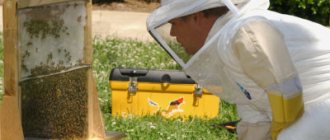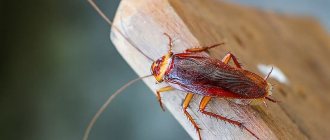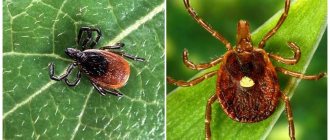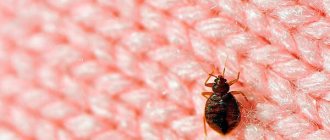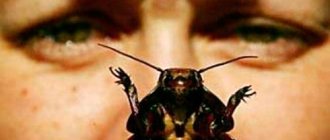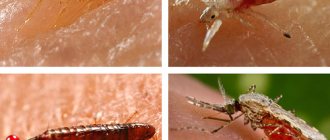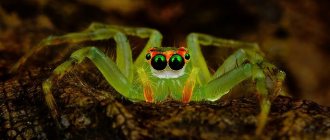A cockroach in the ear is a rare but probable situation, especially if parasites are densely settled in an apartment or hotel. Although cockroaches usually shy away from people, at night these insects can expand their activity zones and reach a person’s resting place.
If the cockroach is small enough, the person does not notice the insect's invasion and continues to sleep peacefully. However, already in the morning an unpleasant sensation appears in the auricle, which intensifies over time and causes more and more discomfort.
Symptoms of an insect getting into the ear
It is difficult not to notice the presence of an insect in the auricle. Hard wings, long whiskers, and shell will irritate delicate tissues, causing discomfort.
They will intensify as the parasite approaches the eardrum. The cockroach will be constantly moving, trying to find a way out, so there will be no periods of calm.
Signs of a cockroach in the ear:
- feeling of ear fullness, foreign object in the ear canal;
- sensation of noise - rustling, loud knocking, sharp sound, rumble;
- sensation of a cockroach advancing;
- severe pain in the ear canal (may radiate to the temple);
- itching, irritation along the ear canal;
- pain when pressing on the auricle;
- secretion of mucus, blood;
- hearing impairment.
If the pest has crawled far and reached the vestibular apparatus, then the main symptoms will include dizziness, attacks of nausea, vomiting, pain and heaviness in the head. People with diseases of the nervous system may experience seizures.
For any person, this situation is unpleasant; he will experience depression, panic, and try to get the cockroach out. It is not always possible to get rid of an insect on your own, since it is difficult to get to it. You don’t need to remove the insect yourself, you need to ask someone or see a doctor.
How dangerous are cockroaches to humans?
Let's take a closer look at the harm of cockroaches to people.
It is a mistake to believe that “mustachios” are only a purely externally unpleasant phenomenon. They are carriers of many dangerous diseases . Their very way of life indicates that on their paws they can carry harmful bacteria and a huge number of pathogenic microbes.
Pests look for their food in trash cans, basements, and sewers. All microorganisms and bacteria linger on their furry paws . And after that they begin to explore all corners of your apartment, crawling on dishes and kitchen tables.
And even if you do not observe insects in a mug or glass at the moment, they have already managed to settle microbes on them that can become a source of serious infectious diseases.
What diseases are carried:
- Salmonellosis.
- Meningitis.
- Mycobacteriosis.
- Gastroenteritis.
- Dysentery.
- Urogenital viruses.
- Lichen.
- Tetanus.
- Infectious hepatitis.
Black species can infect you with helminths : pinworms, roundworms, tapeworms, whipworms. Red cockroaches can also become a source of worms. Moreover, the ways of spreading diseases can be very different. They can leave parasite eggs on any objects that you touch with your hands. Therefore, it is very important to take measures to prevent the spread of insects in your home.
The total number of microbes and viruses they carry, according to scientists, is more than a hundred.
The result of proximity to them is infectious diseases. At the same time, the person mistakenly believes that he caught the virus in transport or a public place, but in fact he fell ill in his own apartment, just by touching things on which the “uninvited guest” had previously crawled.
Cockroach in a child's ear
Children's ears are small, but domestic parasites can get into them too. It's important to remember that cockroaches usually get stuck in the ear canals because they don't know how to move backwards. The symptoms will be the same as in adults.
The parasites, with their progress, will begin to irritate the soft tissues inside the ear canal. The child will scratch his ears and cry. Small children may not understand where it hurts or what noise is in their head.
Cockroaches cannot get into a child's ear through the nose, although there are nasopharyngeal connections. But these passages are winding and thin. They are filled with natural mucus secretions, so there is no need to worry about this.
It will also prevent cockroaches from breeding in your ears. They won't live that long in a cramped place. Even if this happens, the small individuals will run out and will not stay inside. Insects will not get to the brain, as many are afraid. It's too deep. The lack of air will scare the cockroach; it will not climb further.
Allergy
The chitinous cover, excrement, and remains of these insects are mixed with house dust and become a source of allergic reactions in humans. If they enter the respiratory tract, skin or stomach of a person, they can cause the following allergic reactions:
- Skin dermatitis.
- Conjunctivitis.
- Rhinitis.
- Asthma.
Symptoms of a cockroach allergy. Constantly in contact with insects in your own home, a person suffers from chronic allergies. As a result, he constantly sneezes and experiences pain in his eyes and nose. At the same time, black cockroaches emit a strong odor , which, even in the absence of allergies, can cause a lot of unpleasant moments.
Can I get it myself?
The best option would be to go to a medical facility. Using special instruments, the doctor will examine the auricle and correctly remove the parasite. It is important to determine what damage the cockroach caused with its paws and to treat the wound surface.
Sometimes it is not possible to contact a specialist, for example, if a problem occurs while hiking or in a suburban area. In such cases, you have to rely on your own strength and get the pest out yourself.
The victim himself is strictly forbidden to pick his ear. This can only push the parasite deeper. Third parties must pull it out, provided that the insect has not crawled very deep.
Without special knowledge, the signs of ear diseases can be confused; they are often similar. The unbearable sensations that a person feels when a cockroach crawls into his ear occur with the development of other diseases. In order not to confuse diseases, there is no need to diagnose yourself.
Signs of the presence of a foreign body in the ear canal are characteristic of otitis media (ear inflammation). Especially when the inflammatory process has reached the inner ear.
With sulfur plugs, similar symptoms occur. Also, when a non-living foreign body is in the ear canal, similar manifestations are possible, for example, when there is a cherry pit in the ear.
If you were bitten
do not attack people without special reasons .
But if there are no open sources of food and water in the house, they try to extract them from the human body.
When there are many individuals in the house, they do not have enough food, and they begin to feed on the human body.
A cockroach bite is similar to most insect bites. After some time, a seal appears in its place, which begins to itch very much , a burning sensation and tingling appear.
Bites are dangerous due to the possibility of allergies and wound infection . Often the wound becomes inflamed due to viruses that have entered it. The delicate skin of children especially suffers from this. Most of all they love to chew the skin on the fingers and toes , and the areas around the lips, eyelids, elbows and knees. The bite sites begin to itch and become inflamed.
IMPORTANT! Cockroach bites must be treated, otherwise severe inflammatory processes may develop in their place.
Self extraction
It is strictly forbidden to remove an insect from the ear with tweezers, knitting needles, sticks, or any sharp objects. This will not help you catch the insect, but it can damage your hearing.
First you need to determine the location of the pest; to do this, shine a flashlight into your ear or look with a magnifying glass. We need to take a good look at how far he crawled. The victim should be placed on the healthy ear, and a light should be directed into the ear with the cockroach.
Next, you need to try to get rid of the parasite using a simple method. Tilt the ear with the cockroach down, tug on the lobe. The ear will begin to move, the parasite may fall out. There is hope that the method will work. This must be done several times, giving the insect the opportunity to crawl out and fold its wings.
If it was not possible to remove the cockroach in this way, then it must be killed so that it does not move further, and only then removed. You need to act slowly but surely, especially when extracting from children. There is no need to scare them again.
Action diagram:
- Heat any vegetable oil to room temperature.
- Place the victim horizontally, with the injured ear facing up.
- Drop oil from a pipette into the cockroach's ear. Adults take 1 pipette, children need half.
- Wait 10 minutes until the parasite dies from lack of air. Proof of his death will be the cessation of sounds, that is, of all movement.
Attention! Water is not used for such purposes; the cockroach will take longer to die, bringing pain to the injured person.
Rinse the auricle with warm water to wash away the insect.
Be sure to inspect the body of the cockroach so that all its parts come out and nothing remains inside.
To wash out a cockroach, you can simply slowly inject water into your ear using a syringe (without a needle). The cockroach may surface. If this does not work, then a large amount of water is poured in, then the head must be tilted so that the liquid pours out.
You can’t pour water on a living cockroach, it will run away and hide even further. It will be especially difficult to pull him out; such actions will cause a lot of suffering to the victim.
It is important to remember that nothing should be poured into the ear if blood is flowing from it or if there is loss of hearing. These are signs of serious damage.
After removing the insect, the ear canal must be carefully treated with hydrogen peroxide to destroy pathogenic bacteria.
How to remove a dead cockroach from your ear
After the foreign sensations in the ear canal stop, they begin to remove the remains of the cockroach. The most effective methods:
- Fill the syringe with warm water. Lie down with the affected ear facing the ceiling and gradually release water into the ear canal from a syringe without a needle. The cockroach's corpse will be pushed out of the ear due to the difference in density.
- An intensive rinsing option - with a shower jet. Remove the shower head and leave only the movable hose. Run a thick stream of warm water into your ear and hold for 20-30 seconds. The same method is effective for removing ear plugs.
- If the ear canal is completely blocked by a cockroach (the ear cannot hear anything), an ear hook is used to remove the insect corpse. This is a medical instrument that is placed on one side of a foreign body to push it from behind. You cannot carry out this procedure on your own; you need to consult a doctor.
Even if the cockroach was successfully removed the first time, make an appointment with an otolaryngologist to check the integrity of the ear canals.
When can only a doctor help?
Sometimes it is necessary to immediately contact a specialist - an otolaryngologist, without even trying to get any insect yourself.
If you have chronic ear pathologies, you should not pour oil or water into the ear canal, as this may cause complications. If there is bleeding from the ear or mucus discharge, or hearing loss, you only need to see a doctor.
The organ of hearing is complex in structure, fragile, and not designed for mechanical loads. The specialist has instruments to widen the ear canal to remove the insect.
There are special devices for sucking out foreign objects. Everything will be done using more gentle methods than with self-extraction.
Recovery period
After removing the insect from the auricle, it is necessary to restore auditory functions. This may require medications and special physiotherapy. After washing or suction, there may be a feeling of pressure in the ear, unpleasant nausea, and attacks of dizziness.
For some time after removing the insect, experts recommend avoiding active recreation, physical activity, sudden movements, driving vehicles, and working at heights associated with maintaining balance.
During this time you need to give up alcoholic beverages and smoking. All unpleasant symptoms should be reported to your doctor so treatment can be adjusted. If you follow the recommendations, the unpleasant symptoms will soon disappear.
Cockroaches easily spread infection on their bodies. During the week you need to pay attention to changes in your body.
Signs of infection:
- increase in body temperature;
- aching ear pain;
- dizziness;
- swelling of the ear;
- hearing impairment.
The appearance of such symptoms should alert you. You should not self-medicate, you should go to the doctor.
Prevention measures
In order to avoid such problems, you need to fight against domestic insects and prevent them from becoming widespread in the apartment. Small children need to wear thick hats at night to protect their ears. For adults, earplugs or simple pieces of cotton wool in their ears will help.
When hiking, it is necessary to ensure that the tent is airtight. Along the perimeter you can lay out aromatic herbs that cockroaches, ants, and other insects cannot tolerate, for example, tansy (fresh or dry).
No need to eat in a tent. Teach children that this is a place to rest at night. If there is no food, the insects will not come.
The main method of prevention remains getting rid of cockroaches. There are many ways to say goodbye to these domestic parasites forever. They are not only unpleasant to look at, but are carriers of dangerous diseases - tetanus, dysentery, lichen, salmonellosis, urogenital viruses.
Cockroach extermination company services
The best way to protect yourself and family members from attacks by cockroaches is to prevent them from appearing in the house, and if pests are detected, promptly begin extermination measures. Getting rid of Prussians on your own is not an easy and not always solvable task due to the high resistance of individuals to pesticides. Cockroach oothecae are not at all susceptible to insecticides.
The sanitary service "Des Group" offers residents and enterprises of Moscow and the Moscow region services for treating premises from cockroaches. Exterminators go to apartments and country houses, to commercial facilities of any profile.
